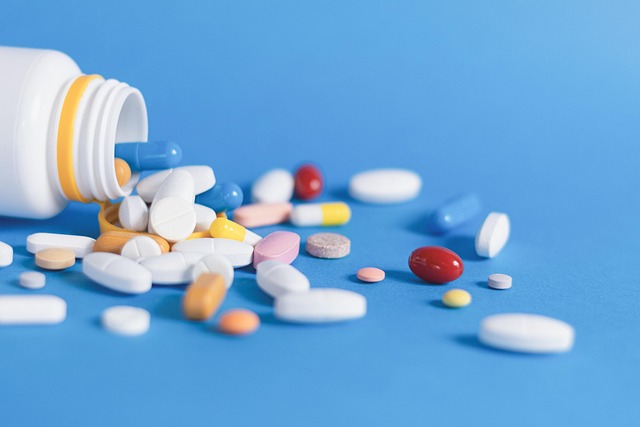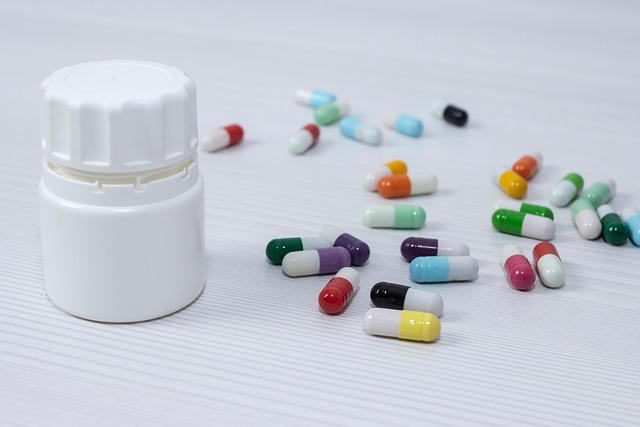GLP-1 agonists, mimicking gut hormone GLP-1, are key in managing type 2 diabetes and significantly enhancing cardiovascular health. These drugs lower blood pressure, reduce inflammation, improve lipid metabolism, and offer anti-inflammatory, pro-regenerative, and angiogenic benefits. Clinical trials confirm their safety and efficacy, with mild gastrointestinal side effects being the most common. While long-term use carries risks like pancreatitis and kidney issues, personalized dosing strategies and ongoing monitoring mitigate these dangers. Future developments aim to improve GLP-1 drug administration and expand their role in treating cardiovascular diseases.
GLP-1 agonists, natural hormones that mimic gut-derived peptides, have emerged as powerful tools in cardiovascular health management. This article delves into the multifaceted role of these innovative medications. We explore their mechanisms, impact on blood sugar regulation, and surprising cardiovascular benefits. Through clinical trials, we uncover their safety and efficacy, comparing them to traditional treatments. Additionally, we discuss potential side effects, optimal dosing, future research directions, and personalized medicine approaches with GLP-1 drugs, highlighting their growing significance in modern cardiology.
Understanding GLP-1 Agonists and Their Mechanisms in the Body

GLP-1 agonists are a class of drugs that mimic the actions of glucagon-like peptide-1 (GLP-1), a hormone produced in the gut in response to food intake. They play a crucial role in regulating blood sugar levels by stimulating insulin secretion when needed and suppressing glucagon release, helping to lower blood glucose. Beyond their effects on glycemic control, GLP-1 drugs have been found to possess significant cardiovascular benefits.
These agonists act on specific receptors in various organs, including the heart, vessels, and kidneys, leading to reduced blood pressure, improved vascular function, and decreased risk of cardiovascular events. They can also modulate inflammation, promote cell regeneration, and enhance the formation of new blood vessels, all of which contribute to overall cardiovascular health.
The Impact of GLP-1 Drugs on Blood Sugar Regulation

GLP-1 drugs, or glucagon-like peptide-1 agonists, play a pivotal role in regulating blood sugar levels. They mimic the effects of the natural hormone GLP-1, which is secreted by the gut in response to food intake. By activating specific receptors, these drugs stimulate insulin secretion from the pancreas, especially in the presence of elevated glucose levels. This action helps lower blood sugar, making them a powerful tool in managing type 2 diabetes.
Beyond their role in glycemic control, GLP-1 drugs have cardiovascular benefits. They exhibit anti-inflammatory properties and can reduce vascular resistance, contributing to improved blood flow and reduced risk of cardiovascular events. Additionally, these drugs have been shown to lower blood pressure, further emphasizing their importance in maintaining overall cardiovascular health.
Cardiovascular Benefits Arising from GLP-1 Receptor Activation

The activation of GLP-1 receptors through GLP-1 drug administration offers a range of cardiovascular benefits. One key advantage is their ability to reduce blood pressure, which can significantly lower the risk of heart disease and stroke. This effect is attributed to GLP-1’s stimulation of nitric oxide production in blood vessels, leading to vasodilation and decreased resistance. Additionally, these drugs promote improvements in lipid metabolism by increasing fat oxidation and decreasing triglyceride levels, thereby reducing the burden on cardiovascular systems.
GLP-1 agonists also play a role in improving heart function. They can enhance cardiac contractility and improve electrometric stability, which is crucial for maintaining optimal heartbeat rhythms. Furthermore, these drugs have anti-inflammatory properties that may protect against vascular damage and heart failure, contributing to overall cardiovascular health.
Clinical Trials Demonstrating the Safety and Efficacy of GLP-1 Agonists

Clinical trials have played a pivotal role in establishing the safety and efficacy of GLP-1 agonists as a therapeutic approach for cardiovascular health. These drugs, which mimic the effects of the natural hormone GLP-1, have shown remarkable potential in reducing major adverse cardiovascular events (MACE) in high-risk patients. Numerous studies have demonstrated their ability to lower blood pressure, improve endothelial function, and reduce inflammation, all of which contribute to a healthier cardiovascular system.
The comprehensive testing has revealed that GLP-1 drugs are generally well-tolerated, with the most common side effects being mild to moderate gastrointestinal issues. Despite this, the benefits outweigh the risks, as evidenced by multiple meta-analyses and large-scale clinical trials. This body of research provides a strong foundation for healthcare professionals to consider GLP-1 agonists as a valuable addition to cardiovascular risk management strategies.
Comparison: GLP-1 Drugs vs. Traditional Cardiovascular Medications

GLP-1 drugs, or glucagon-like peptide-1 agonists, have emerged as a promising novel therapeutic approach in cardiovascular health, offering unique benefits compared to traditional medications. Unlike conventional drugs that often focus on blocking specific pathways, GLP-1 drugs mimic the natural hormone GLP-1, which plays a crucial role in regulating blood sugar levels and has additional cardiovascular advantages.
One of the key distinctions lies in their mode of action. While traditional cardiovascular medications may target symptoms or risk factors, such as lowering cholesterol or reducing blood pressure, GLP-1 drugs take a more holistic approach. They not only improve insulin sensitivity and glycemic control but also possess anti-inflammatory properties, promote vasodilation, and reduce platelet aggregation. This multifaceted mechanism of action contributes to their potential in preventing cardiovascular events, making them a game-changer in the management of heart health, especially for patients with diabetes or prediabetes.
Potential Side Effects and Risks Associated with Long-Term Use

While GLP-1 agonists have shown significant promise in improving cardiovascular health, it’s crucial to consider their potential side effects and risks, especially with long-term use. Some patients may experience gastrointestinal disturbances like nausea, vomiting, or diarrhea, which often lessen over time. More seriously, these drugs can lead to an increased risk of pancreatitis, a condition that requires medical attention. Additionally, GLP-1 drugs may cause low blood sugar levels (hypoglycemia), particularly when combined with other diabetes medications.
Long-term use also raises concerns about potential effects on the kidney. Studies suggest a possible link between GLP-1 agonists and an increased risk of kidney problems, including acute kidney injury. Furthermore, as these drugs can influence various metabolic processes, they may have unintended consequences on liver function. Regular monitoring during extended treatment periods is essential to identify and mitigate these risks effectively.
Optimal Dosing Strategies for GLP-1 Agonist Therapy

In optimal GLP-1 agonist therapy, dosing strategies play a crucial role in achieving cardiovascular health benefits while minimising adverse effects. The choice of dosage depends on various factors including patient characteristics and treatment goals. Typically, these drugs are administered once or twice daily via subcutaneous injection, with dosages ranging from 30 to 200 micrograms. Start doses are often lower, gradually titrated upwards to the optimal level over a few weeks. This cautious approach allows for individualised therapy, balancing blood sugar control and cardiovascular risks.
Research suggests that higher doses of GLP-1 drugs may confer greater cardiovascular benefits, but they also increase the risk of gastrointestinal side effects such as nausea and vomiting. Therefore, it’s essential to monitor patients closely during treatment, adjusting dosages accordingly. Regular follow-ups with healthcare providers are vital to assess treatment response and make necessary adjustments, ensuring a safe and effective GLP-1 agonist therapy for each patient.
Future Perspectives: Emerging Research and Innovations in GLP-1 Drug Development

The future of GLP-1 drug development promises exciting innovations that could further enhance their role in cardiovascular health. Emerging research is exploring the potential of novel GLP-1 agonists with improved pharmacokinetic profiles, allowing for more convenient dosing regimens and better patient adherence. These advancements are set to address one of the key challenges associated with current GLP-1 therapies—the need for frequent injections. Additionally, scientists are delving into the complex mechanisms of action of GLP-1, aiming to design drugs that can target specific pathways involved in cardiovascular protection, thereby providing more tailored and effective treatments.
Another area of focus is combining GLP-1 drugs with other therapeutic agents to create synergistic effects, especially in managing comorbidities such as diabetes and hypertension. Such combinatorial approaches could lead to reduced doses of individual medications, minimizing side effects and improving overall patient outcomes. Furthermore, preclinical studies suggest that GLP-1-based therapies might have anti-inflammatory properties, opening up possibilities for treating inflammation-driven cardiovascular diseases. These ongoing advancements highlight the potential for GLP-1 drugs to revolutionize cardiovascular care in the future.
Exploring Personalized Medicine Approaches with GLP-1 Agonists

In the pursuit of personalized medicine, GLP-1 agonists present a promising avenue for cardiovascular health management. These drugs, designed to mimic the effects of the natural hormone GLP-1, offer a tailored approach to treating conditions like type 2 diabetes and prediabetes. By targeting specific pathways involved in glucose regulation and cardiovascular function, GLP-1 drugs can provide benefits beyond blood sugar control, such as reducing the risk of cardiovascular events.
Personalized medicine approaches leverage the unique characteristics of each individual’s biology, including their genetic makeup and lifestyle factors. In the context of GLP-1 agonists, this might involve selecting the most effective drug and dosage based on an individual’s genetic profile or using these drugs in combination with other therapies to optimize cardiovascular health outcomes. This tailored strategy has the potential to significantly improve patient care and treatment efficacy.
